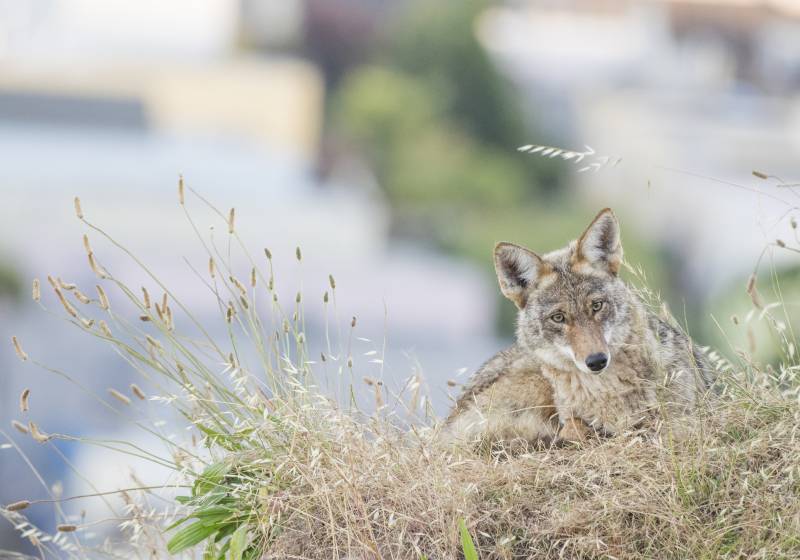We don’t know the exact number of coyotes in the Bay Area. There’s no rigorous program to track them. But Campbell estimates there are “dozens” of coyotes in the city today — probably not more than 100.
“There’s no way to truly know the population, just like how we would not be able to say how many raccoons live in the city. We pick up close to 30 dead coyotes each year,” Campbell said, noting they are mostly hit by cars.
To help understand coyote behavior, animal control started collecting phone and email reports of coyote sightings in 2006 and via an online form in 2017. “These community-curated data sets that have all this information about people’s experiences are really special,” Wilkinson said.
The data helps researchers like Wilkinson get a sense of coyote sighting trends and what’s happening on the ground with the coyotes and their behavior and ecology.
When do dog conflicts increase?
Coyote pupping season typically runs from March until September. It’s the time when female coyotes are getting ready to give birth to their pups and when their pups are born. Coyote parents are more protective of their homes or denning areas.
In early summer, coyote parents are more active and protective of their pups as their young ones venture out of their dens.
“We get a lot of reports during denning and pupping season where coyotes will follow people with dogs, usually medium to large dogs, arch their back, show their teeth, basically they do their best to look menacing — all behaviors that are saying ‘go away,’” Campbell said.
Coyotes exhibit these protective behaviors towards canines, according to the Presidio website. Places like the Presidio, where many of our coyotes roam, typically close sections of trails near a den area to dog walking during pupping season.
Campbell said the coyotes will “escort” or follow dogs away from their dens until they feel the dog is no longer a threat. “People walking their dogs often mistake this protective behavior for aggression,” Campbell said.
An unintended consequence of the COVID-19 pandemic lockdowns between 2020 and 2022 was an increase in coyote conflicts, which could be due to the animals having more space for themselves, with less human interaction, Wilkinson said.
What is normal coyote behavior? What should I do if a coyote approaches me (and my dog)?
We should remember that coyotes are timid animals with a natural fear of humans.
Although they tend to be most active in the evenings and early mornings, they can move around throughout the day.
Urban coyotes don’t have many large predators and have not learned to view humans as hunting predators.
If you find yourself within 50 feet of a coyote, and it approaches you or does not move away, animal control officials recommend that you make yourself appear big, yell, wave your arms, maintain eye contact with them and practice other hazing techniques.
Campbell emphasizes that small dogs should be picked up and all dogs should be on leashes, no matter what size. Coyotes look at small dogs as prey — like rabbits or squirrels — and can snatch them if an opportunity presents itself. All the small dogs taken by coyotes in San Francisco have been off-leash.
“We can’t stress enough how important it is to keep dogs on leash for their safety,” she said.
Campbell advises people to haze persistent coyotes or try to frighten them into leaving. Shaking a can full of pennies, popping an umbrella or opening a plastic garbage bag — things that make a loud noise — will usually convince a coyote to move along.
But this doesn’t work near dens. Coyotes protecting dens will not be affected by hazing. “Their pups are too important to them,” Campbell said.
Always look out for signs posted about coyote activity in the city. They could be indicators that dens are nearby. The best thing to do, Campbell said, is avoid these areas in the first place. But if you encounter a coyote or are being “escorted” away from a coyote’s den, you should slowly walk away and not run.
What can we do to make coexisting with coyotes easier?
Feeding coyotes is illegal and can have trickle-down effects that influence coyote behavior, Wilkinson said. If city coyotes become too aggressive, then officials with animal control might have to remove them.
“The wildcard in all of this is intentional feeding,” Campbell said. Coyotes can lose their natural wariness of humans when people feed them, and they may begin to approach unsuspecting folks looking for an easy handout. They will return to neighborhoods with an easy food source and walk up to others to see if anyone else is willing to give them dinner.
“It’s frustrating for our agency, the wildlife experts we work with, and the people living in neighborhoods where their neighbors just keep feeding and attracting coyotes,” animal control’s Campbell said.
Campbell and Wilkinson encourage us to contribute coyote sighting reports in the Bay Area.
They also recommend educating yourself and your neighbors about how to appropriately haze, what circumstances you should and shouldn’t do so, and what’s normal and not normal coyote behavior.
“Do a little due diligence because it’s a team sport to get to a place of coexistence with our urban wildlife,” Wilkinson said.
Studies like the one Wilkinson is leading help researchers understand how to work with community members to tailor outreach to people’s needs. “In the end, it’s the folks that are experiencing these challenges or interactions on the ground that are the ones that are going to be the first responders to creating coexistence with these animals,” Wilkinson said.
Here’s where you can report your coyote sightings in San Francisco. And here’s another form to report sightings in the East Bay and Marin.
San Francisco residents can call animal control at 415-554-9400 for immediate assistance with animal-related emergencies, like a coyote acting strangely, or to report an injured, ill or dead coyote.
